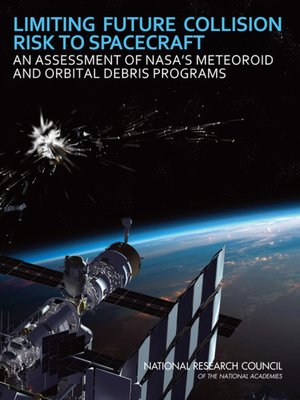Limiting Future Collision Risk to Spacecraft
ebook ∣ An Assessment of NASA's Meteoroid and Orbital Debris Programs
By National Research Council

Sign up to save your library
With an OverDrive account, you can save your favorite libraries for at-a-glance information about availability. Find out more about OverDrive accounts.
Find this title in Libby, the library reading app by OverDrive.



Search for a digital library with this title
Title found at these libraries:
| Library Name | Distance |
|---|---|
| Loading... |
Derelict satellites, equipment and other debris orbiting Earth (aka space junk) have been accumulating for many decades and could damage or even possibly destroy satellites and human spacecraft if they collide. During the past 50 years, various National Aeronautics and Space Administration (NASA) communities have contributed significantly to maturing meteoroid and orbital debris (MMOD) programs to their current state. Satellites have been redesigned to protect critical components from MMOD damage by moving critical components from exterior surfaces to deep inside a satellite's structure. Orbits are monitored and altered to minimize the risk of collision with tracked orbital debris. MMOD shielding added to the International Space Station (ISS) protects critical components and astronauts from potentially catastrophic damage that might result from smaller, untracked debris and meteoroid impacts.
Limiting Future Collision Risk to Spacecraft: An Assessment of NASA's Meteoroid and Orbital Debris Program examines NASA's efforts to understand the meteoroid and orbital debris environment, identifies what NASA is and is not doing to mitigate the risks posed by this threat, and makes recommendations as to how they can improve their programs. While the report identified many positive aspects of NASA's MMOD programs and efforts including responsible use of resources, it recommends that the agency develop a formal strategic plan that provides the basis for prioritizing the allocation of funds and effort over various MMOD program needs. Other necessary steps include improvements in long-term modeling, better measurements, more regular updates of the debris environmental models, and other actions to better characterize the long-term evolution of the debris environment.







